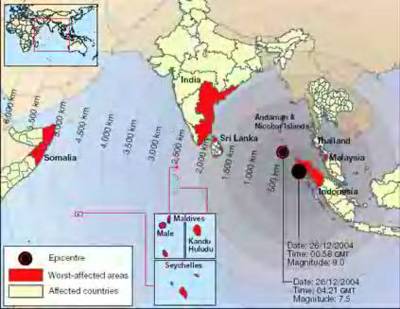
The Resonance of the Indian Ocean Tsunami of December 26, 2004

Nature 433, 3 (06 January 2005); doi:10.1038/433003b
Triple slip of tectonic plates caused seafloor surge
MICHAEL HOPKIN
Biggest quake in 40 years redraws the map.
In the aftermath of the tsunami that devastated coastlines around the Indian Ocean, experts are piecing together details of the seismic slip that sparked the waves. The earthquake, the world's biggest for more than 40 years and the fourth largest since 1900, has literally redrawn the map, moving some islands by up to 20 metres.
The destruction, which claimed as many as 150,000 lives, was unleashed by a 'megathrust' — a sudden juddering movement beneath the sea floor. A build-up of pressure caused the floor of the Indian Ocean to lurch some 15 metres towards Indonesia, burrowing under a tectonic plate and triggering the ferocious swells that smashed into surrounding shores.
The earthquake followed almost two centuries of tension during which the India plate pressed against the Burma microplate, which carries the tip of Sumatra as well as the Andaman and Nicobar Islands. The plates move against one another at an average rate of about 6 centimetres a year, but this movement does not occur smoothly. There has not been a very large quake along this fault since 1833 — a fact that may have contributed to the huge force of this one. The India plate's jarring slide released the tension on the Burma microplate, causing it to spring violently upwards.
Quakes of this type, called subduction earthquakes, are commonplace throughout the world, but rarely strike with such force, says Roger Musson of the British Geological Survey in Edinburgh. "This is the largest earthquake I've seen in my career as a seismologist," he says. "The length of the rupture was 1,200 kilometres — I could hardly believe it."
The earthquake, measured at magnitude 9.0, actually consisted of three events that occurred within seconds of each other, Musson explains. The initial slip, which happened to the west of Sumatra's northern tip, triggered two further slips to the north. The total force released was enough to jolt the entire planet.
The seafloor bulge unleashed a wave that surged through the Indian Ocean. Initially, the energy of such a wave is distributed throughout the water column, and surface perturbation is small. Only when the water grows shallow, near the coast, does the wave emerge on the surface as a tsunami — the name is Japanese for 'harbour wave'. In this case, the wave hit Indonesia and Thailand within an hour, and then Sri Lanka and India, ultimately reaching as far as eastern Africa.
....................................
Nature 433, 4 (06 January 2005); doi:10.1038/433004a
Tsunamis: a long-term threat
QUIRIN SCHIERMEIER
Other regions around the globe are at higher risk.
Last month's tsunami tragedy, shocking as it was, had ample historical precedent. On 1 November 1755, for example, a fire following an earthquake destroyed two-thirds of Lisbon, Portugal. In panic, the population sought shelter near the shoreline, only to be hit by waves said to be as high as houses. More than 60,000 people died.
Devastating tsunamis are known in historical times to have affected the populated coasts of Papua New Guinea, Japan, Hawaii, Crete, Sicily and the Crimea — to name just a few. In the Pacific region, where 80% of all tsunamis occur, a 1947 analysis indicated that seismic sea waves higher than 7.5 metres occur on average every 15 years1. Records going back to 684 BC refer to four Pacific tsunamis higher than 30 metres.
Outside the Pacific, tsunami frequencies have been studied in some detail only for the Aegean and Black Sea regions. Records there reveal that the coastal and surrounding areas of Turkey have been affected by more than 90 tsunamis over the past 3,000 years2.
For most other areas, information concerning the return periods of tsunamis is scarce. A rough comparison of tsunami frequencies in different parts of the globe was done in 2000 by the London-based Benfield Hazard Research Centre, as part of its Tsunami Risks Project. The resulting risk analysis estimates the return periods of 10-metre waves to be about 1,000 years for the North Atlantic and Indian oceans, southern Japan and the Caribbean, 500 years for the Philippines and the Mediterranean Sea, 250 years for Alaska, South America and Kamchatka in eastern Siberia, and less than 200 years for Hawaii and the southwest Pacific.
The south Asian disaster will have a "huge effect" on instigating more thorough risk assessments, predicts Bill McGuire, a volcanologist and director of the London research centre, as well as encouraging preventive measures in threatened regions.